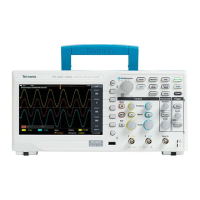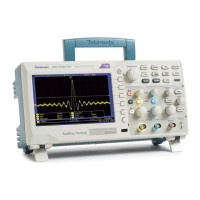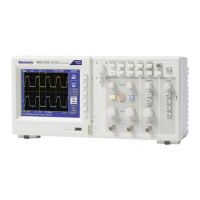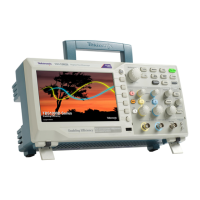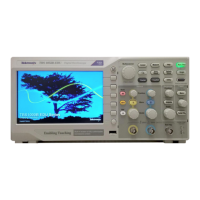Theory of Operation
Processing and Display
System
The processing
and display system consists of the display ASIC, DRA M, and
system oscillator. Digitized acquisition samples are received by the display
ASIC and stored in DRAM. Once data are received by the display ASIC, various
corrections are applied, display rasterization is performed, and the w aveform is
placed in a display buffer. At the same time, the waveform is read from the display
buffers and written to the LCD. Additional circuitry in the display ASIC supports
scanning th
e front panel, handling DRAM refresh, providing the processor
clock, and performing various memory mapping tasks required by all elementary
microprocessor based systems. In a 4 –channel system, the two display ASICs are
interconnected so that one ASIC can provide display information for the second.
The processing and display system handles some of the computational tasks.
Other tasks are performed by the processor system. Since all array processing
is performed in the processing and display system, no computations can be
performed that involve data from two different channel sets. Thus, subtracting
channel 3 data from channel 2 is prohibited. Channel 1 and Channel 2 data may
be combined in all of the supported ways.
Input Signal Interface
BNC connectors are mounted on the Main board for all signal inputs. The signal
inputs are compatible with the supplied TPP0101 and TPP0201 probes.
Probe Compensation
The Probe Comp and ground terminals are provided for probe adjustment.
External Trigger
The Ext Trig channel is processed on the chain containing the highest numbered
normal input channel.
Main Board Power
To support various functions on the M ain board, several secondary power sup
plies
are generated. For the amplifier and acquisition ASICs, the Main board creates a
+2.5 V and -2.5 V supply. The +2.5 V supply is derived from the +3.3 V logic
supply. The -2.5 V supply is derived from the -4 V supply. One three-terminal
regulator provides +5 V for internal uses. A second three-terminal regulator
provides U SB power to preclude USB faults from seriously disrupting operation
of the oscilloscope.
Power Supply
The main power supply module for these oscilloscopes is a wide input range
universal supply. It can provide about 25 W of power for the oscilloscope, while
allowing the input to run from about 90 V to 264 V. Input frequency ranges from
47 Hz to 440 Hz, which allows operation in virtually all countries in the world and
in several off-grid environments, such as pow er on military aircraft.
The secondary supplies from the power supply and the approximate current draws
are listed in a table with the associated connector pins on J101. (See Table 6-5.)
3–4 TBS1000 Series O scilloscope Service Manual
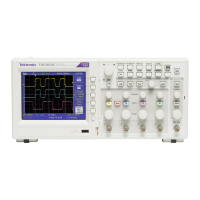
